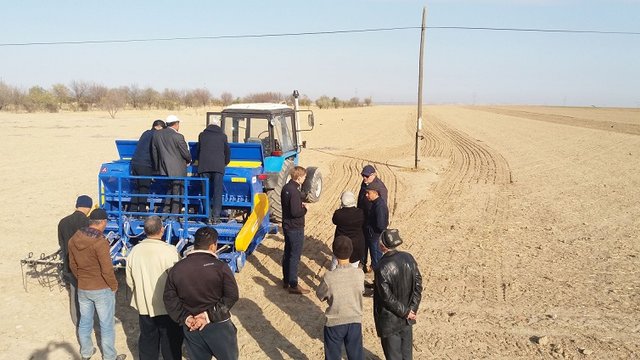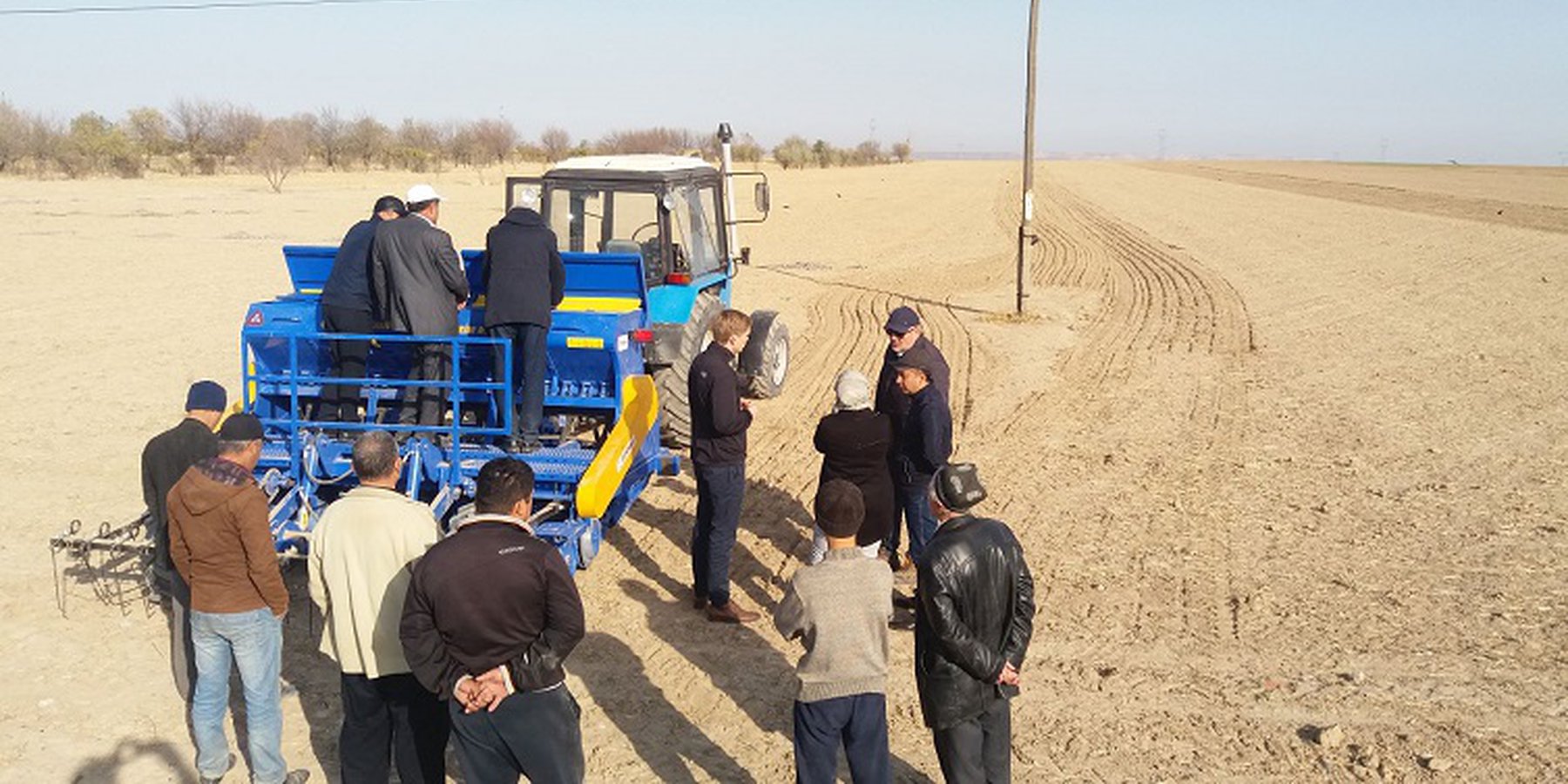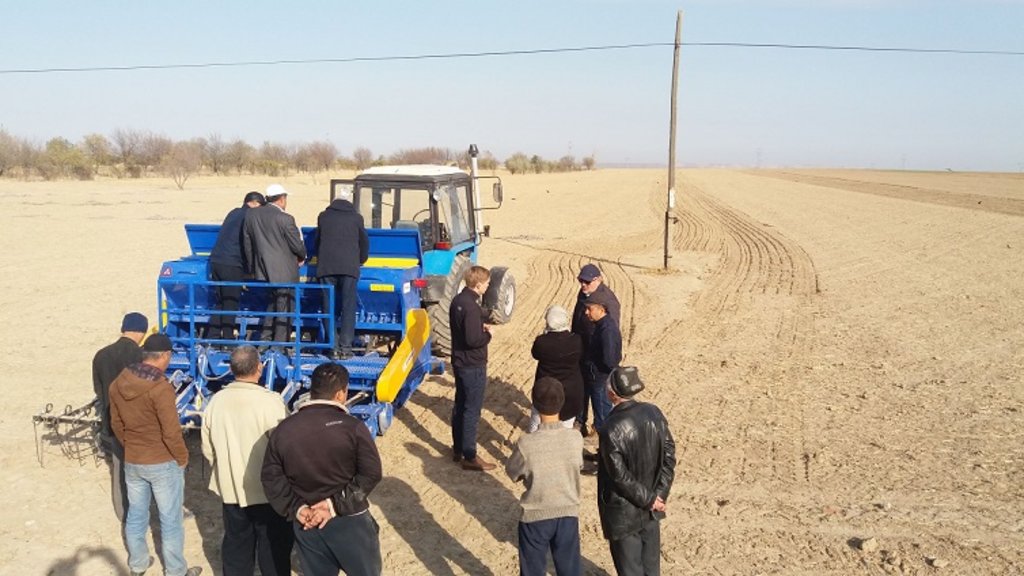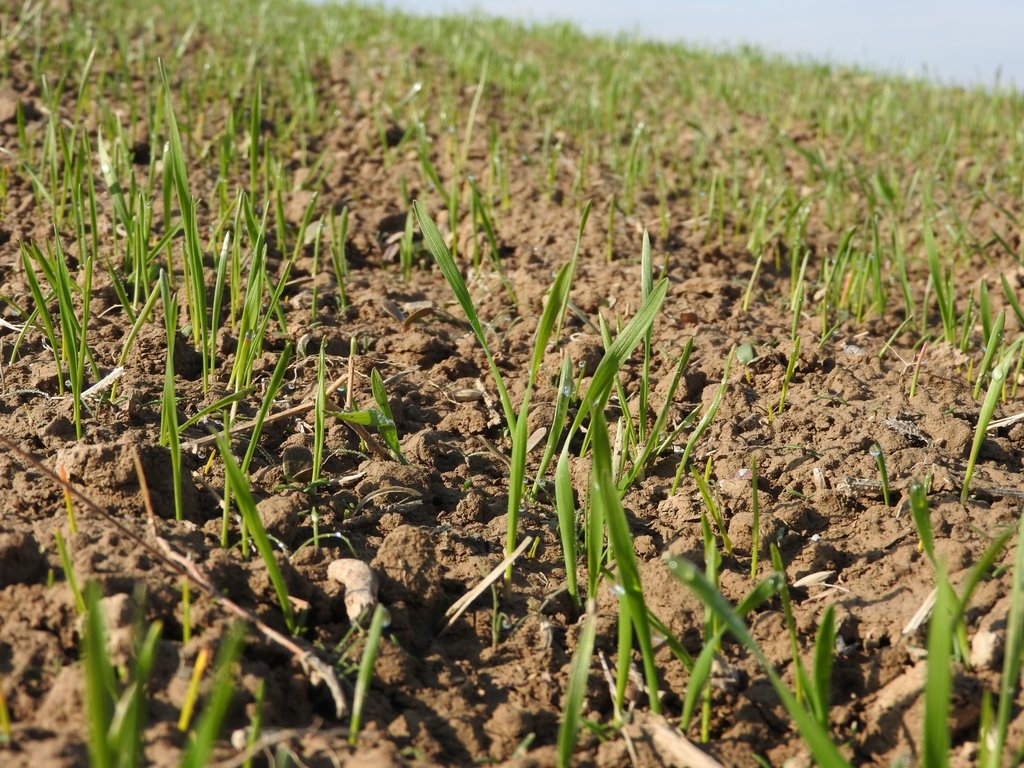Applying zero tillage technology for climate change sensitive rain-fed arable farming [Tajikistan]
- Creation:
- Update:
- Compiler: Stefan Michel
- Editor: –
- Reviewer: Umed Vahobov
Примение безпахотной технологии для богарного земледелия, адаптированной к изменениям климата
technologies_4303 - Tajikistan
View sections
Expand all Collapse all1. General information
1.2 Contact details of resource persons and institutions involved in the assessment and documentation of the Technology
Key resource person(s)
SLM specialist:
Negmatov Negmatjon
Deutsche Gesellschaft für Internationale Zusammenarbeit (GIZ)
Tajikistan
Name of project which facilitated the documentation/ evaluation of the Technology (if relevant)
Strengthening of Livelihoods through Climate Change Adaptation in Kyrgyzstan and Tajikistan {'additional_translations': {}, 'value': 619, 'label': 'Name of the institution(s) which facilitated the documentation/ evaluation of the Technology (if relevant)', 'text': 'Deutsche Gesellschaft für Internationale Zusammenarbeit - Tajikistan (GIZ Tajikistan) - Tajikistan', 'template': 'raw'}1.3 Conditions regarding the use of data documented through WOCAT
The compiler and key resource person(s) accept the conditions regarding the use of data documented through WOCAT:
Yes
1.4 Declaration on sustainability of the described Technology
Is the Technology described here problematic with regard to land degradation, so that it cannot be declared a sustainable land management technology?
No
1.5 Reference to Questionnaire(s) on SLM Approaches (documented using WOCAT)

Integrated rain-fed farming of cereals for adaptation to … [Tajikistan]
Rain-fed agriculture faces challenges from climate change impact, inappropriate crop varieties and inadequate inputs. The approach of integrated rain-fed farming reduces the adverse effect of climate change impacts and improves the income of farmers.
- Compiler: Stefan Michel
2. Description of the SLM Technology
2.1 Short description of the Technology
Definition of the Technology:
Direct sowing and application of fertilizer without ploughing reduces land degradation risks associated with conventional arable farming and saves costs for farmers while improving the resilience against climate change impact, in particular drought.
2.2 Detailed description of the Technology
Description:
By zero tillage technology (also called direct seeding, direct sowing or direct drilling) seed of cultivated crops is placed without mechanical treatment of the topsoil. Within one operation the residues from previous crops and weeds are superficially removed, seeds are planted, fertilizer applied and covered by soil. For the purpose of weed control the field is ploughed every third year. Also herbizides are used for weed control. The special drilling machine used for this provides the opportunity of regulating the density of sowing and the dosage of applied fertilizer in accordance to the yield potential of the site, which is typically determined by soils fertility and moisture.
In comparison with the traditional methods of arable farming the application of the zero tillage technology (direct drilling) reduces the following risks from the ecology and agronomy point of view: soil compaction, lump formation, destruction of the soil and dust formation, and manifestation of water and wind erosion. Also, the decrease of organic matter and the destruction of the habitat of soil organisms caused by intensive mechanical soil treatment are reduced. The avoiding of breaking up and turning the upper soil horizon hampers the evaporation from the soil surface and increases the soil moisture.
From the economic perspective, with the use of zero tillage technology (direct sowing) farmers can save the expenses for ploughing, leveling, chiseling that significantly reduces the costs of farmers. Improved soil moisture reduces drought-related risks of rain-fed winter wheat farming. Despite the fact, that the season of 2017-2018 was unusually dry and cold, the direct drilling technology showed good result impressing local farmers.
The technology has been demonstrated at two demo plots (each 2.5 hectares) for cultivation of wheat crop, established in Devashtich district during the 2017 agriculture season. To ensure longer-term sustainability of the idea and quick dissemination among the farmers, the local Non-commercial cooperative “Agra va iqlim” was engaged as a local partner, which has been assisted in the purchase of a combined drilling and fertilizing machine (“Özdöken”, Made in Turkey). Additionally wheat varieties have been provided, which are particularly suitable for rain-fed farming and can cope with due to climate change increasing aridity in the area: “Sultan” (Turkey), “Sarvar” (Tajikistan), “Krasnodar99” and “Moskovskiy93” (Russia). These varieties are high growing and provide a good amount of straw, which is in high demand by livestock owners in the region (1.7 TJS per kg).
As a result, during the agricultural season 2017/2018 already 50 involved farmers applied the technology for 50 hectares of rain-fed land for winter wheat. During 2018/2019 an expansion of involved farmers to approx. 150 and of the coverage area to 150 hectares of land for cultivation of winter wheat is planned.
2.3 Photos of the Technology
2.5 Country/ region/ locations where the Technology has been applied and which are covered by this assessment
Country:
Tajikistan
Region/ State/ Province:
Sughd region
Further specification of location:
J. Rasulov district and Istaravshan district
Specify the spread of the Technology:
- applied at specific points/ concentrated on a small area
Is/are the technology site(s) located in a permanently protected area?
No
Map
×2.6 Date of implementation
Indicate year of implementation:
2017
If precise year is not known, indicate approximate date:
- less than 10 years ago (recently)
2.7 Introduction of the Technology
Specify how the Technology was introduced:
- through projects/ external interventions
3. Classification of the SLM Technology
3.1 Main purpose(s) of the Technology
- improve production
- reduce, prevent, restore land degradation
- adapt to climate change/ extremes and its impacts
- create beneficial economic impact
3.2 Current land use type(s) where the Technology is applied
Land use mixed within the same land unit:
No

Cropland
- Annual cropping
Annual cropping - Specify crops:
- cereals - barley
- cereals - wheat (spring)
- cereals - wheat (winter)
- oilseed crops - sunflower, rapeseed, other
Number of growing seasons per year:
- 1
Is intercropping practiced?
No
Is crop rotation practiced?
No
3.3 Has land use changed due to the implementation of the Technology?
Has land use changed due to the implementation of the Technology?
- No (Continue with question 3.4)
3.4 Water supply
Water supply for the land on which the Technology is applied:
- rainfed
3.5 SLM group to which the Technology belongs
- minimal soil disturbance
3.6 SLM measures comprising the Technology

agronomic measures
- A3: Soil surface treatment
- A5: Seed management, improved varieties
- A6: Residue management
A3: Differentiate tillage systems:
A 3.1: No tillage
A6: Specify residue management:
A 6.3: collected
3.7 Main types of land degradation addressed by the Technology

soil erosion by water
- Wt: loss of topsoil/ surface erosion
- Wg: gully erosion/ gullying

soil erosion by wind
- Et: loss of topsoil

water degradation
- Ha: aridification
3.8 Prevention, reduction, or restoration of land degradation
Specify the goal of the Technology with regard to land degradation:
- reduce land degradation
4. Technical specifications, implementation activities, inputs, and costs
4.2 General information regarding the calculation of inputs and costs
Specify how costs and inputs were calculated:
- per Technology area
Indicate size and area unit:
ha
other/ national currency (specify):
TJS
If relevant, indicate exchange rate from USD to local currency (e.g. 1 USD = 79.9 Brazilian Real): 1 USD =:
8.0
4.3 Establishment activities
| Activity | Timing (season) | |
|---|---|---|
| 1. | Purchase of drilling machine |
4.4 Costs and inputs needed for establishment
| Specify input | Unit | Quantity | Costs per Unit | Total costs per input | % of costs borne by land users | |
|---|---|---|---|---|---|---|
| Equipment | Drilling machine | 1.0 | 140500.0 | 140500.0 | ||
| Total costs for establishment of the Technology | 140500.0 | |||||
| Total costs for establishment of the Technology in USD | 17562.5 | |||||
Comments:
The investment for the purchase of the drilling machine was made by the project. The machine is owned and leased to farmers by the extension service of "Agra va iqlim". Farmers pay for the use of the machine and these revenues will be used for maintenance, future replacement of the machine and purchase of additional machines as demand grows due to the spread of the technology.
4.5 Maintenance/ recurrent activities
| Activity | Timing/ frequency | |
|---|---|---|
| 1. | Application of herbizides | |
| 2. | Combined drilling, fertilizer application and removal of residues | November or March / once |
| 3. | Fertilizing | Spring, once |
| 4. | Harvest | June - August |
4.6 Costs and inputs needed for maintenance/ recurrent activities (per year)
| Specify input | Unit | Quantity | Costs per Unit | Total costs per input | % of costs borne by land users | |
|---|---|---|---|---|---|---|
| Equipment | Drilling machine services | ha | 1.0 | 380.0 | 380.0 | 100.0 |
| Equipment | Services for spraying herbicides and other pesticides | ha | 1.0 | 100.0 | 100.0 | 100.0 |
| Equipment | Fertilizer application | ha | 1.0 | 150.0 | 150.0 | 100.0 |
| Plant material | Wheat seeds | kg | 200.0 | 3.2 | 640.0 | 100.0 |
| Fertilizers and biocides | AmmoPhos | kg | 100.0 | 3.75 | 375.0 | 100.0 |
| Fertilizers and biocides | CarbamidN | kg | 100.0 | 3.0 | 300.0 | 100.0 |
| Fertilizers and biocides | Herbicide Granstar WDG | kg | 0.02 | 2000.0 | 40.0 | 100.0 |
| Fertilizers and biocides | Herbicide Dezormon 600 (2.4-D amine salt) | l | 0.8 | 100.0 | 80.0 | 100.0 |
| Fertilizers and biocides | Fungicide Tilt EC | l | 0.5 | 270.0 | 135.0 | 100.0 |
| Total costs for maintenance of the Technology | 2200.0 | |||||
| Total costs for maintenance of the Technology in USD | 275.0 | |||||
Comments:
The capacity of the drilling machine is 150 ha per season, during one year - winter and summer season - it can reach 300 ha.
4.7 Most important factors affecting the costs
Describe the most determinate factors affecting the costs:
The costs of machinery and fuel for cultivation of the soil are substantial. The zero tillage technology allows for saving of 75-80% of these costs.
5. Natural and human environment
5.1 Climate
Annual rainfall
- < 250 mm
- 251-500 mm
- 501-750 mm
- 751-1,000 mm
- 1,001-1,500 mm
- 1,501-2,000 mm
- 2,001-3,000 mm
- 3,001-4,000 mm
- > 4,000 mm
Specify average annual rainfall (if known), in mm:
440.00
Specifications/ comments on rainfall:
According to Mr. Mamadyorov, the Head of the Agricultural department of Devashtich district annual rainfall in the rain-fed areas is 250-300 mm only, of which rainfall during end April-May is most important, together with rainfall in fall and winter.
Indicate the name of the reference meteorological station considered:
Ghonchi
Agro-climatic zone
- semi-arid
5.2 Topography
Slopes on average:
- flat (0-2%)
- gentle (3-5%)
- moderate (6-10%)
- rolling (11-15%)
- hilly (16-30%)
- steep (31-60%)
- very steep (>60%)
Landforms:
- plateau/plains
- ridges
- mountain slopes
- hill slopes
- footslopes
- valley floors
Altitudinal zone:
- 0-100 m a.s.l.
- 101-500 m a.s.l.
- 501-1,000 m a.s.l.
- 1,001-1,500 m a.s.l.
- 1,501-2,000 m a.s.l.
- 2,001-2,500 m a.s.l.
- 2,501-3,000 m a.s.l.
- 3,001-4,000 m a.s.l.
- > 4,000 m a.s.l.
5.3 Soils
Soil depth on average:
- very shallow (0-20 cm)
- shallow (21-50 cm)
- moderately deep (51-80 cm)
- deep (81-120 cm)
- very deep (> 120 cm)
Soil texture (topsoil):
- medium (loamy, silty)
Soil texture (> 20 cm below surface):
- medium (loamy, silty)
Topsoil organic matter:
- medium (1-3%)
5.4 Water availability and quality
Ground water table:
5-50 m
Availability of surface water:
medium
Is flooding of the area occurring?
No
5.5 Biodiversity
Species diversity:
- low
Habitat diversity:
- low
5.6 Characteristics of land users applying the Technology
Sedentary or nomadic:
- Sedentary
Market orientation of production system:
- commercial/ market
Off-farm income:
- less than 10% of all income
Relative level of wealth:
- average
Individuals or groups:
- individual/ household
- cooperative
Level of mechanization:
- mechanized/ motorized
Gender:
- women
- men
Age of land users:
- middle-aged
5.7 Average area of land used by land users applying the Technology
- < 0.5 ha
- 0.5-1 ha
- 1-2 ha
- 2-5 ha
- 5-15 ha
- 15-50 ha
- 50-100 ha
- 100-500 ha
- 500-1,000 ha
- 1,000-10,000 ha
- > 10,000 ha
Is this considered small-, medium- or large-scale (referring to local context)?
- small-scale
- medium-scale
5.8 Land ownership, land use rights, and water use rights
Land ownership:
- state
Land use rights:
- leased
- individual
Are land use rights based on a traditional legal system?
No
5.9 Access to services and infrastructure
health:
- poor
- moderate
- good
education:
- poor
- moderate
- good
technical assistance:
- poor
- moderate
- good
employment (e.g. off-farm):
- poor
- moderate
- good
markets:
- poor
- moderate
- good
energy:
- poor
- moderate
- good
roads and transport:
- poor
- moderate
- good
drinking water and sanitation:
- poor
- moderate
- good
financial services:
- poor
- moderate
- good
6. Impacts and concluding statements
6.1 On-site impacts the Technology has shown
Socio-economic impacts
Production
crop production
Quantity before SLM:
1-1.1 t/ha
Quantity after SLM:
1.2-1.5 t/ha
Comments/ specify:
Drought year - higher production increase possible in good years.
Income and costs
expenses on agricultural inputs
Quantity before SLM:
2630 TJS/ha
Quantity after SLM:
2200 TJS/ha
Comments/ specify:
Reduction of expenses for soil cultivation, sowing and application of fertilizer.
Ecological impacts
Water cycle/ runoff
evaporation
Soil
soil moisture
soil loss
soil organic matter/ below ground C
6.2 Off-site impacts the Technology has shown
downstream siltation
6.3 Exposure and sensitivity of the Technology to gradual climate change and climate-related extremes/ disasters (as perceived by land users)
Gradual climate change
Gradual climate change
| Season | increase or decrease | How does the Technology cope with it? | |
|---|---|---|---|
| seasonal temperature | summer | increase | well |
| seasonal rainfall | wet/ rainy season | decrease | well |
6.4 Cost-benefit analysis
How do the benefits compare with the establishment costs (from land users’ perspective)?
Short-term returns:
positive
Long-term returns:
positive
How do the benefits compare with the maintenance/ recurrent costs (from land users' perspective)?
Short-term returns:
positive
Long-term returns:
positive
Comments:
Initial investment in machinery covered by external funding, recovery of costs and expension by payments for use of machinery by farmers.
6.5 Adoption of the Technology
- 1-10%
If available, quantify (no. of households and/ or area covered):
2017/2018 - 50, 2018/2019 - 150
Of all those who have adopted the Technology, how many did so spontaneously, i.e. without receiving any material incentives/ payments?
- 91-100%
6.6 Adaptation
Has the Technology been modified recently to adapt to changing conditions?
No
6.7 Strengths/ advantages/ opportunities of the Technology
| Strengths/ advantages/ opportunities in the land user’s view |
|---|
| Reduced number of operations for soil cultiviation and related cost reduction. |
| Higher yield in drough year compared to conventionally cultivated fields. |
| Technology can make rain-fed arable farming less risky. |
| Strengths/ advantages/ opportunities in the compiler’s or other key resource person’s view |
|---|
| Reduced number of operations for soil cultiviation and related cost reduction. Higher yield. Better resilience to climate change impact, in particular to drought. |
| Reduced soil erosion, higher accumulaton of soil organic matter, preservation of soil organisms, reduced evaporation and more retained humidity. |
| Potential for expansion in terms of area, application in other crops. |
6.8 Weaknesses/ disadvantages/ risks of the Technology and ways of overcoming them
| Weaknesses/ disadvantages/ risks in the land user’s view | How can they be overcome? |
|---|---|
| Perceived reduced infiltration compared to ploughing. | Perception changed by observation on demonstration plots. |
| Potentially increasing weed abundance. | Annual application of herbicides and ploughing every third year. |
| Weaknesses/ disadvantages/ risks in the compiler’s or other key resource person’s view | How can they be overcome? |
|---|---|
| Crop residues on the soil surface can spread straw-borne diseases | Crop residues are minimized by collecting and using of straw. |
| Uneven distribution of harvest residues cannot be corrected | Drilling machine used for redistribution of residues. |
| Weeds have to be controlled with chemicals | Use of herbicides with proofen minimum impact and persistence. |
| Wheel tracks and soil compaction cannot be mechanically repaired | Ploughing every three years. |
7. References and links
7.1 Methods/ sources of information
- field visits, field surveys
- interviews with land users
- interviews with SLM specialists/ experts
- compilation from reports and other existing documentation
Links and modules
Expand all Collapse allLinks

Integrated rain-fed farming of cereals for adaptation to … [Tajikistan]
Rain-fed agriculture faces challenges from climate change impact, inappropriate crop varieties and inadequate inputs. The approach of integrated rain-fed farming reduces the adverse effect of climate change impacts and improves the income of farmers.
- Compiler: Stefan Michel
Modules
No modules








